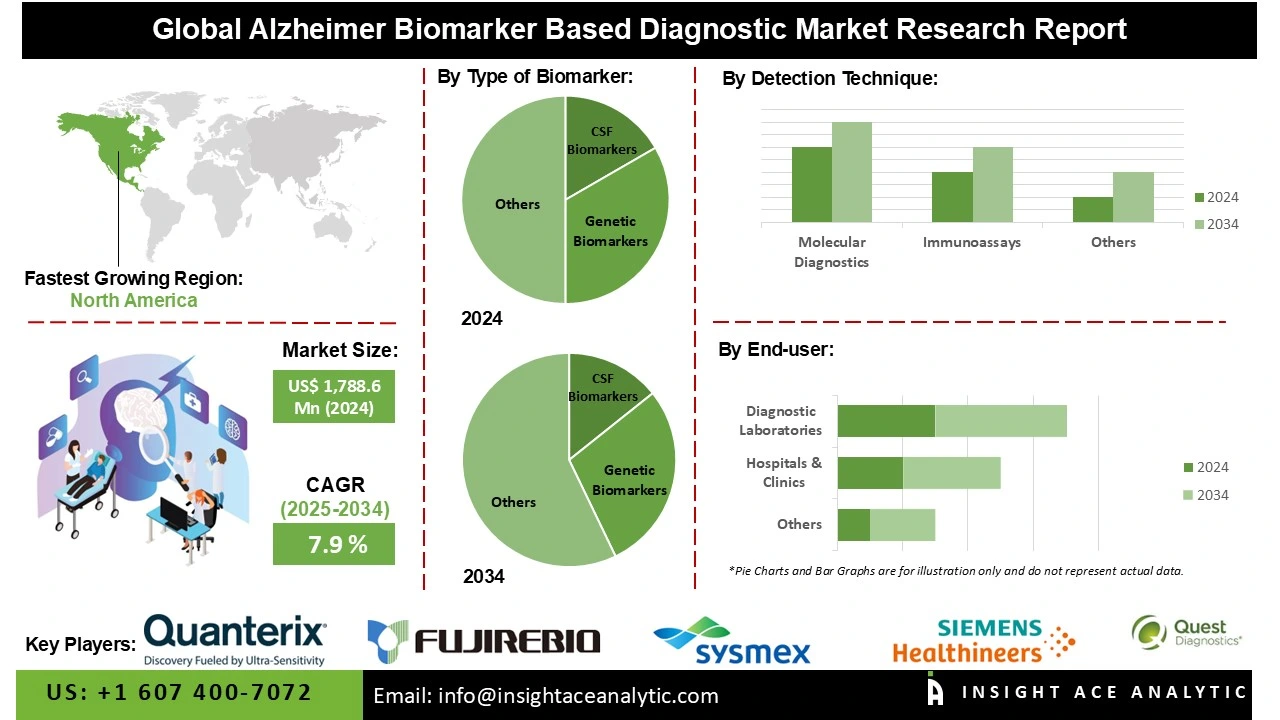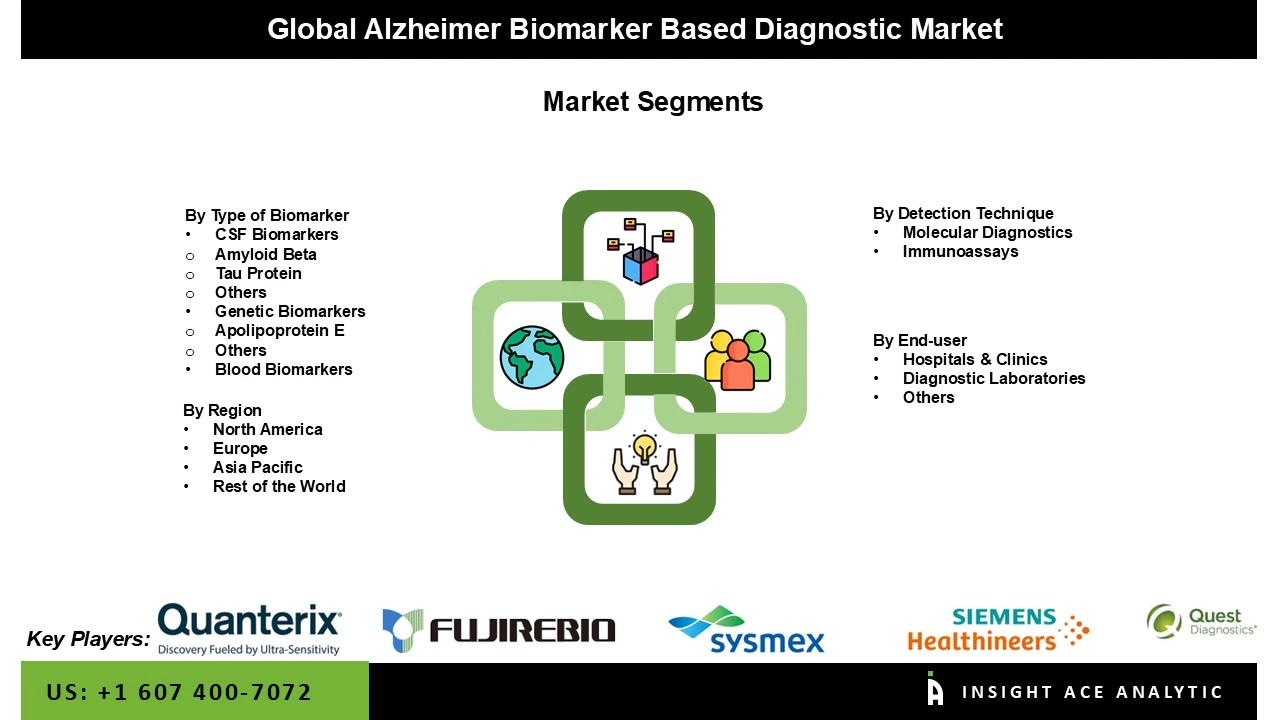Global Alzheimer Biomarker Based Diagnostic Market Size is valued at US$ 864.3 Mn in 2024 and is predicted to reach US$ 1,788.6 Mn by the year 2034 at an 7.9% CAGR during the forecast period for 2025-2034.
The Alzheimer's Disease Diagnostic Biomarker is mainly applied to figure out and confirm a diagnosis of Alzheimer's disease clinically and accurately using biomarkers - specifically, the amyloid-beta, tau, and neurofilament light chains. These diagnostic markers facilitate clinicians to manage disease progression, personalize treatment, and measure treatment response.

They are used in clinical trials for patient stratification and evaluating drug effects, which may uniquely contribute to the drug development pipeline. Additionally, biomarker-based diagnostic Alzheimer's assessments may facilitate preventative care, risk assessment, and early intervention for improved outcomes for patients. The biomarkers provide investigators the opportunity to assess biomarker outcomes in exploring disease mechanisms and, when developing novel therapies, prove useful in assessing drug application, implicating a dual role as biomarkers in the clinical and research pursuits of neurodegenerative disorders.
The global market for Alzheimer's biomarker-based diagnostics is growing, driven primarily by the rising worldwide prevalence of Alzheimer's disease and other dementias, especially within ageing populations. This growth is further boosted by the rapidly increasing adoption of biomarker tests, which enable rapid and accessible detection, facilitating timely intervention, personalized treatment, and efficient disease management in on-demand healthcare services.
Demographic trends underscore this expansion. According to the World Health Organization (WHO), there were 125 million people aged 80 years or older in 2018. Furthermore, the WHO estimated that the proportion of the worldwide population aged 60 years as well as over would nearly double, rising from 12% in 2015 to 22% by 2050.
Despite this positive outlook, several factors are restraining market growth. These include the high cost of diagnostic tests, limited accessibility in lower-income regions, regulatory challenges, and ethical concerns surrounding early diagnosis in the absence of a cure.
Some of the Key Players in the Alzheimer Biomarker Based Diagnostic Market:
The Alzheimer Biomarker Based Diagnostic market is segmented by Type of Biomarker, Detection Technique, and End-user. By Type of Biomarker, the market is segmented into CSF Biomarkers, including Amyloid Beta, Tau Protein, and Others; Genetic Biomarkers, including Apolipoprotein E, and Others; and Blood Biomarkers. By Detection Technique, the market is segmented into Molecular Diagnostics, and Immunoassays. As per the end-user, the market is segmented into Hospitals & Clinics, Diagnostic Laboratories, and Others.
The blood biomarkers category led the alzheimer biomarker based diagnostic market in 2024. This convergence is due to their generally non-invasive and cost-effective nature, and relative ease of use compared to testing blood with imaging or cerebrospinal fluid (CSF); these tests will become more widely used. Blood-based biomarkers, such as amyloid-beta, tau proteins, or neurofilament light chains (NfL), can provide a reliable association with clinical diagnosis for the early detection or monitoring of disease. Growing acceptance and use of blood-based tests in the clinical space and clinical research, along with the effect of more healthcare providers willing to advocate for their patients to have early diagnosis, means that patient compliance and accessibility to testing will keep on growing. With additional advances in technology and regulatory clearances for blood-based diagnostic tests, the blood-based biomarker market will continue to dominate testing not only in developed markets but also in emerging markets.
The largest and fastest-growing detection technique, molecular diagnostics, is due to its high sensitivity, specificity, and ability to diagnose Alzheimer’s disease based on its biomarker profiles and other related proteins. Molecular detection techniques, including PCR (Polymerase Chain Reaction), immunoassays, and the use of next-generation sequencing, provide precise identification and quantification of important proteins like amyloid-beta and tau protein(s) for supporting earlier diagnosis and personalized therapies. The use of molecular detection methods also enables elderly and dementia patient stratification in clinical drug trials and assists with drug development. In addition, continued technology innovation in molecular diagnostics, the greater use of artificial intelligence (AI) analytics with biomarker research, and increasing demand for non-invasive and accurate diagnostic solutions, is driving the greater molecular diagnostics share in the detection market segment globally.
North America dominated the Alzheimer Biomarker Based Diagnostic market in 2024. The United States is at the forefront of this expansion. This is due to the advanced healthcare framework, wide adoption of advanced diagnostic technologies, and strong research and clinical trial networks. Meanwhile, a combination of rigorous government initiatives and investment, and widespread awareness programs (all of which continue to proliferate) also materially elevate the market confidence. Further, an accelerated aging population and high incidence of Alzheimer’s disease will continue to promote demand for early and accurate biomarker-based diagnostics in the market.
Advanced healthcare framework, widespread adoption of advanced diagnostic technologies, and strong research and clinical trial networks in the Asia-Pacific area, the Alzheimer Biomarker Based Diagnostic market is expanding at the strongest and fastest rate in this region. Meanwhile, a combination of rigorous government initiatives and investment, and widespread awareness programs (all of which continue to proliferate) also materially elevate the market confidence. Further, an accelerated aging population and high incidence of Alzheimer’s disease will continue to promote demand for early and accurate biomarker-based diagnostics in the market.
Alzheimer Biomarker Based Diagnostic Market by Type of Biomarker-
· CSF Biomarkers
o Amyloid Beta
o Tau Protein
o Others
· Genetic Biomarkers
o Apolipoprotein E
o Others
· Blood Biomarkers

Alzheimer Biomarker Based Diagnostic Market by Detection Technique-
· Molecular Diagnostics
· Immunoassays
Alzheimer Biomarker Based Diagnostic Market by End-user-
· Hospitals & Clinics
· Diagnostic Laboratories
· Others
Alzheimer Biomarker Based Diagnostic Market by Region-
North America-
· The US
· Canada
Europe-
· Germany
· The UK
· France
· Italy
· Spain
· Rest of Europe
Asia-Pacific-
· China
· Japan
· India
· South Korea
· Southeast Asia
· Rest of Asia Pacific
Latin America-
· Brazil
· Argentina
· Mexico
· Rest of Latin America
Middle East & Africa-
· GCC Countries
· South Africa
· Rest of the Middle East and Africa
Chapter 1. Methodology and Scope
1.1. Research Methodology
1.2. Research Scope & Assumptions
Chapter 2. Executive Summary
Chapter 3. Global Alzheimer Biomarker Based Diagnostic Market Snapshot
Chapter 4. Global Alzheimer Biomarker Based Diagnostic Market Variables, Trends & Scope
4.1. Market Segmentation & Scope
4.2. Drivers
4.3. Challenges
4.4. Trends
4.5. Investment and Funding Analysis
4.6. Porter's Five Forces Analysis
4.7. Incremental Opportunity Analysis (US$ MN), 2025-2034
4.8. Competitive Landscape & Market Share Analysis, By Key Player (2024)
4.9. Use/impact of AI on Alzheimer Biomarker Based Diagnostic Market Industry Trends
4.10. Global Alzheimer Biomarker Based Diagnostic Market Penetration & Growth Prospect Mapping (US$ Mn), 2024-2034
Chapter 5. Alzheimer Biomarker Based Diagnostic Market Segmentation 1: By Type of Biomarker, Estimates & Trend Analysis
5.1. Market Share by Type of Biomarker, 2024 & 2034
5.2. Market Size Revenue (US$ Million) & Forecasts and Trend Analyses, 2021 to 2034 for the following Type of Biomarker:
5.2.1. CSF Biomarkers
5.2.1.1. Amyloid Beta
5.2.1.2. Tau Protein
5.2.1.3. Others
5.2.2. Genetic Biomarkers
5.2.2.1. Apolipoprotein E
5.2.2.2. Others
5.2.3. Blood Biomarkers
Chapter 6. Alzheimer Biomarker Based Diagnostic Market Segmentation 2: By Detection Technique, Estimates & Trend Analysis
6.1. Market Share by Detection Technique, 2024 & 2034
6.2. Market Size Revenue (US$ Million) & Forecasts and Trend Analyses, 2021 to 2034 for the following Detection Technique:
6.2.1. Molecular Diagnostics
6.2.2. Immunoassays
Chapter 7. Alzheimer Biomarker Based Diagnostic Market Segmentation 3: By End User, Estimates & Trend Analysis
7.1. Market Share by End User, 2024 & 2034
7.2. Market Size Revenue (US$ Million) & Forecasts and Trend Analyses, 2021 to 2034 for the following End User:
7.2.1. Hospitals & Clinics
7.2.2. Diagnostic Laboratories
7.2.3. Others
Chapter 8. Alzheimer Biomarker Based Diagnostic Market Segmentation 4: Regional Estimates & Trend Analysis
8.1. Global Alzheimer Biomarker Based Diagnostic Market, Regional Snapshot 2024 & 2034
8.2. North America
8.2.1. North America Alzheimer Biomarker Based Diagnostic Market Revenue (US$ Million) Estimates and Forecasts by Country, 2021-2034
8.2.1.1. US
8.2.1.2. Canada
8.2.2. North America Alzheimer Biomarker Based Diagnostic Market Revenue (US$ Million) Estimates and Forecasts by Type of Biomarker, 2021-2034
8.2.3. North America High-Altitude Oxygen Simulation Market Revenue (US$ Million) Estimates and Forecasts by Detection Technique, 2021-2034
8.2.4. North America Alzheimer Biomarker Based Diagnostic Market Revenue (US$ Million) Estimates and Forecasts by End User, 2021-2034
8.3. Europe
8.3.1. Europe Alzheimer Biomarker Based Diagnostic Market Revenue (US$ Million) Estimates and Forecasts by Country, 2021-2034
8.3.1.1. Germany
8.3.1.2. U.K.
8.3.1.3. France
8.3.1.4. Italy
8.3.1.5. Spain
8.3.1.6. Rest of Europe
8.3.2. Europe Alzheimer Biomarker Based Diagnostic Market Revenue (US$ Million) Estimates and Forecasts by Type of Biomarker, 2021-2034
8.3.3. Europe Alzheimer Biomarker Based Diagnostic Market Revenue (US$ Million) Estimates and Forecasts by Detection Technique, 2021-2034
8.3.4. Europe Alzheimer Biomarker Based Diagnostic Market Revenue (US$ Million) Estimates and Forecasts by End User, 2021-2034
8.4. Asia Pacific
8.4.1. Asia Pacific Alzheimer Biomarker Based Diagnostic Market Revenue (US$ Million) Estimates and Forecasts by Country, 2021-2034
8.4.1.1. India
8.4.1.2. China
8.4.1.3. Japan
8.4.1.4. Australia
8.4.1.5. South Korea
8.4.1.6. Hong Kong
8.4.1.7. Southeast Asia
8.4.1.8. Rest of Asia Pacific
8.4.2. Asia Pacific Alzheimer Biomarker Based Diagnostic Market Revenue (US$ Million) Estimates and Forecasts by Type of Biomarker, 2021-2034
8.4.3. Asia Pacific Alzheimer Biomarker Based Diagnostic Market Revenue (US$ Million) Estimates and Forecasts by Detection Technique, 2021-2034
8.4.4. Asia Pacific Alzheimer Biomarker Based Diagnostic Market Revenue (US$ Million) Estimates and Forecasts by End User, 2021-2034
8.5. Latin America
8.5.1. Latin America Alzheimer Biomarker Based Diagnostic Market Revenue (US$ Million) Estimates and Forecasts by Country, 2021-2034
8.5.1.1. Brazil
8.5.1.2. Mexico
8.5.1.3. Rest of Latin America
8.5.2. Latin America Alzheimer Biomarker Based Diagnostic Market Revenue (US$ Million) Estimates and Forecasts by Type of Biomarker, 2021-2034
8.5.3. Latin America Alzheimer Biomarker Based Diagnostic Market Revenue (US$ Million) Estimates and Forecasts by Detection Technique, 2021-2034
8.5.4. Latin America Alzheimer Biomarker Based Diagnostic Market Revenue (US$ Million) Estimates and Forecasts by End User, 2021-2034
8.6. Middle East & Africa
8.6.1. Middle East & Africa Wind Turbine Rotor Blade Market Revenue (US$ Million) Estimates and Forecasts by country, 2021-2034
8.6.1.1. GCC Countries
8.6.1.2. Israel
8.6.1.3. South Africa
8.6.1.4. Rest of Middle East and Africa
8.6.2. Middle East & Africa Alzheimer Biomarker Based Diagnostic Market Revenue (US$ Million) Estimates and Forecasts by Type of Biomarker, 2021-2034
8.6.3. Middle East & Africa Alzheimer Biomarker Based Diagnostic Market Revenue (US$ Million) Estimates and Forecasts by Detection Technique, 2021-2034
8.6.4. Middle East & Africa Alzheimer Biomarker Based Diagnostic Market Revenue (US$ Million) Estimates and Forecasts by End User, 2021-2034
Chapter 9. Competitive Landscape
9.1. Major Mergers and Acquisitions/Strategic Alliances
9.2. Company Profiles
9.2.1. Quanterix Corporation
9.2.1.1. Business Overview
9.2.1.2. Key Product /Service Overview
9.2.1.3. Financial Performance
9.2.1.4. Geographical Presence
9.2.1.5. Recent Developments with Business Strategy
9.2.2. Fujirebio Diagnostics
9.2.3. Lantheus Holdings Inc.
9.2.4. Sysmex Corporation
9.2.5. Quest Diagnostics Inc.
9.2.6. Siemens Healthineers AG
9.2.7. Enzo Life Sciences, Inc.
9.2.8. Thermo Fisher Scientific, Inc.
9.2.9. AnaSpec, Inc.
9.2.10. Merck KGaA
9.2.11. Cell Signaling Technology, Inc.
9.2.12. Imagilys
9.2.13. NanoSomiX
9.2.14. QIAGEN
9.2.15. 23andMe, Inc.
9.2.16. C₂N Diagnostics
Alzheimer Biomarker Based Diagnostic Market by Type of Biomarker-
· CSF Biomarkers
o Amyloid Beta
o Tau Protein
o Others
· Genetic Biomarkers
o Apolipoprotein E
o Others
· Blood Biomarkers
Alzheimer Biomarker Based Diagnostic Market by Detection Technique-
· Molecular Diagnostics
· Immunoassays
Alzheimer Biomarker Based Diagnostic Market by End-user-
· Hospitals & Clinics
· Diagnostic Laboratories
· Others
Alzheimer Biomarker Based Diagnostic Market by Region-
North America-
· The US
· Canada
Europe-
· Germany
· The UK
· France
· Italy
· Spain
· Rest of Europe
Asia-Pacific-
· China
· Japan
· India
· South Korea
· Southeast Asia
· Rest of Asia Pacific
Latin America-
· Brazil
· Argentina
· Mexico
· Rest of Latin America
Middle East & Africa-
· GCC Countries
· South Africa
· Rest of the Middle East and Africa